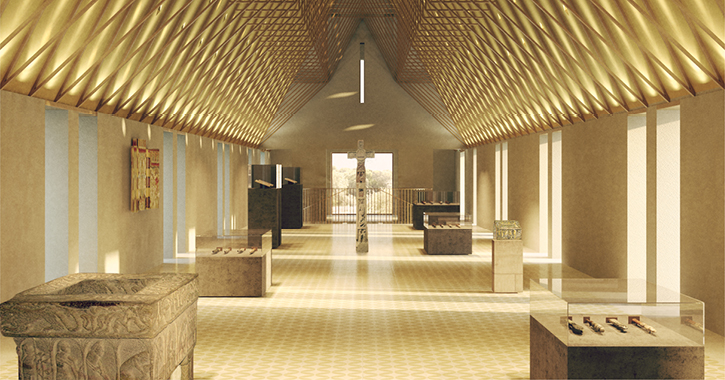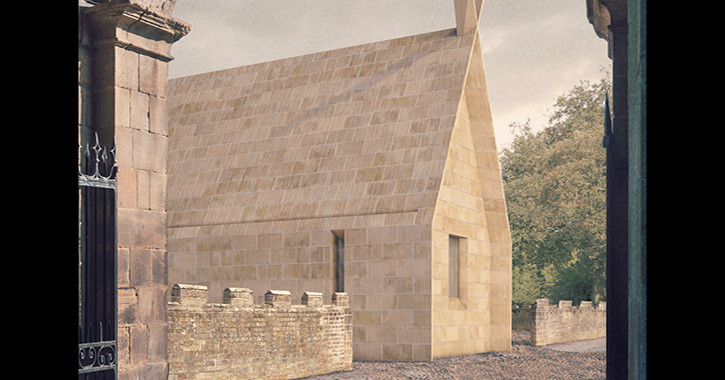It’s been 10 years in the making, and countless challenges have been encountered along the way, but we’ve kept the faith, and now it’s finally ready! The Auckland Project's Faith Museum will open to the public on 7 October 2023.
The Faith Museum explores the multitude of ways faith has shaped lives and communities across Britain, through rarely seen objects, national treasures, personal testimonies and contemporary commissions.

Housed in a 14th-century wing of Auckland Castle and a stunning 21st-century building designed by Níall McLaughlin Architects. The Faith Museum will present over 250 objects from 50 institutions and private collections across England, Scotland and Wales. And the museum's galleries will feature regularly changing displays of objects that invite visitors to consider the ways faith has shaped lives and continues to do so.
The ground floor traces a path through 6,000 years of faith, beginning in the Neolithic period with the powerfully tactile Gainford Stone and ending in the year 2000. The thematic displays will feature objects on loan from 50 national and local institutions and private lenders which complement The Auckland Project’s own collection.
The upper floor of the museum will house a diverse programme of temporary exhibitions and installations, reflecting contemporary issues and timeless ideas. The galleries will open with display of works by ten contemporary British artists, offering their individual perspectives on faith today.
Other museum highlights will include:
- The Binchester Ring. Never-before-displayed, the ring was excavated in 2014 less than a mile from the Castle at the Roman Fort Vinovium, this extraordinary silver ring with carved carnelian stone featuring images of an anchor and fish is rare early evidence of Christianity in Britain.
- An early example of evidence of Jewish communities in Britain seen in an extraordinary object from the collection of the Ashmolean Museum, the 13th-century Bodleian Bowl: this decorated bronze vessel is inscribed with the name of Joseph, son of Rabbi Yechiel, a famous scripture scholar of Paris. Joseph lived in Colchester and may have given this bowl to the Jewish congregation there before leaving for the Holy Land.
- A copy of William Tyndale’s English translation of the New Testament from 1536, one of only a small number to have survived. The publication of Tyndale’s Bible was a key moment in English history, helping spread the ideas of the Reformation and serving as the basis for the King James Version.
- A set of 20th-century prayer beads owned by Lord Headley, believed to be the first Briton to have legitimately completed the Hajj pilgrimage to Mecca, having converted to Islam.

Upstairs, visitors will encounter contemporary expressions of faith in a series of temporary exhibition displays. Dominating the Great Gallery upstairs, with its high-pitched ceiling, is a dramatic installation by Mat Collishaw, specially created for the space. This large-scale work is complemented by more intimate pieces in the adjacent galleries, inviting us to consider how faith can be both awe-inspiring and public, yet personal and private.
In a gallery looking out across the Castle’s walled garden, a collection of paintings by artist Roger Wagner depict Biblical scenes in modern landscapes in a poetic juxtaposition.
The final gallery space invites visitors to reflect on three central questions present throughout the museum: Where do I belong? How do I live? and Am I alone? Among the artists featured are the Singh Twins, known for their amalgamation of Eastern and Western art, and Khadija Saye, the British-Gambian photographer whose work was being exhibited at the Venice Biennale’s Diaspora Pavilion when her life was tragically ended in the Grenfell Tower fire.
The 740sqm museum has seen extensive conservation work undertaken on the historically significant Grade I listed Scotland Wing of Auckland Castle, with refurbishments overseen by Purcell architects. The new purpose-built extension designed by Níall McLaughlin Architects takes the form of a medieval tithe barn and follows the line of the original perimeter wall of the castle. Conceived as a sacred storehouse, the monolithic, pitched roof building was constructed using Cop Crag sandstone, local to the North East, and the same as used at Durham Cathedral.
The Faith Museum is part of the wider restoration and redevelopment of The Auckland Project, at Bishop Auckland, which has been made possible with a £12.4m grant from The National Lottery Heritage Fund.
The Faith Museum is supported by The National Lottery Heritage Fund and the Jerusalem Trust.
Related
Comments
Comments are disabled for this post.
.png)

 to add an item to your Itinerary basket.
to add an item to your Itinerary basket.









